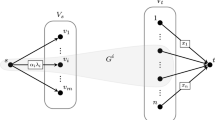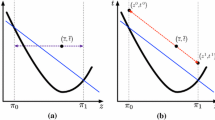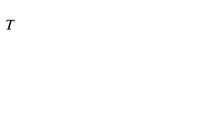Abstract
We introduce techniques to build small ideal mixed-integer programming (MIP) formulations of combinatorial disjunctive constraints (CDCs) via the independent branching scheme. We present a novel pairwise IB-representable class of CDCs, CDCs admitting junction trees, and provide a combinatorial procedure to build MIP formulations for those constraints. Generalized special ordered sets (\({\text {SOS}}k\)) can be modeled by CDCs admitting junction trees and we also obtain MIP formulations of \({\text {SOS}}k\). Furthermore, we provide a novel ideal extended formulation of any combinatorial disjunctive constraints with fewer auxiliary binary variables with an application in planar obstacle avoidance.





Similar content being viewed by others
Notes
The number of auxiliary binary variables is logarithmic in \(|{\varvec{\mathcal {S}}}|\).
The upper bounds of the size of minimum biclique cover of a conflict graph with \(n := |\bigcup _{S \in {\varvec{\mathcal {S}}}} S|\) vertices are the vertex cover number and \(n - \lfloor \log _2(n)\rfloor + 1\) [35]; Neither quantity is upper bounded by \(|{\varvec{\mathcal {S}}}|\).
We only consider the case when \(k=2\) and we use minimal infeasible set directly without defining a hypergraph as in [20].
We select \(\mathcal {T}_1\) to be the subtree with smaller set indices, i.e. i in \(S^i\), in the collection of index sets \({\varvec{\mathcal {S}}}\) in Line 17 of Algorithm 1.
Since all the sets in \({\varvec{\mathcal {S}}}''\) are disjointed with each other, the bicliques in \(\textit{bc}_{{\text {dict}}}[\textit{level}]\) of Algorithm 1 can be merged into one and there are only \(\lceil \log _2(|{\varvec{\mathcal {S}}}|)\rceil \) levels.
References
Adams, W.P., Henry, S.M.: Base-2 expansions for linearizing products of functions of discrete variables. Oper. Res. 60(6), 1477–1490 (2012)
Amilhastre, J., Vilarem, M.C., Janssen, P.: Complexity of minimum biclique cover and minimum biclique decomposition for bipartite domino-free graphs. Discret. Appl. Math. 86(2–3), 125–144 (1998)
Balas, E.: Machine sequencing via disjunctive graphs: an implicit enumeration algorithm. Oper. Res. 17(6), 941–957 (1969)
Balas, E.: Disjunctive programming: cutting planes from logical conditions. In: Nonlinear Programming, pp. 279–312. Elsevier, New York (1975)
Balas, E.: Disjunctive programming. Ann. Discret. Math. 5, 3–51 (1979)
Balas, E.: Disjunctive programming: properties of the convex hull of feasible points. Discret. Appl. Math. 89(1–3), 3–44 (1998)
Beale, E.M.L., Tomlin, J.A.: Special facilities in a general mathematical programming system for non-convex problems using ordered sets of variables. OR 69(447–454), 99 (1970)
Bertsimas, D., Shioda, R.: Algorithm for cardinality-constrained quadratic optimization. Comput. Optim. Appl. 43(1), 1–22 (2009)
Biegler, L.T., Grossmann, I.E., Westerberg, A.W.: Systematic Methods for Chemical Process Design. Prentice Hall, Old Tappan, NJ (United States) (1997)
Bondy, J.A., Murty, U.S.R.: Graph Theory. Springer, Cham (2008)
de Caen, D., Gregory, D.A., Pullman, N.J.: The boolean rank of zero-one matrices. In: Proceedings of the Third Caribbean Conference on Combinatorics and Computing, Barbados, pp. 169–173 (1981)
Chalermsook, P., Heydrich, S., Holm, E., Karrenbauer, A.: Nearly tight approximability results for minimum biclique cover and partition. In: European Symposium on Algorithms, pp. 235–246. Springer (2014)
Chang, T.J., Meade, N., Beasley, J.E., Sharaiha, Y.M.: Heuristics for cardinality constrained portfolio optimisation. Comput. Oper. Res. 27(13), 1271–1302 (2000)
Dai, H., Izatt, G., Tedrake, R.: Global inverse kinematics via mixed-integer convex optimization. Int. J. Robot. Res. 38(12–13), 1420–1441 (2019)
De Berg, M.T., Van Kreveld, M., Overmars, M., Schwarzkopf, O.: Computational Geometry: Algorithms and Applications. Springer, Cham (2000)
Deits, R., Tedrake, R.: Footstep planning on uneven terrain with mixed-integer convex optimization. In: 2014 IEEE-RAS International Conference on Humanoid Robots, pp. 279–286. IEEE (2014)
Deits, R., Tedrake, R.: Efficient mixed-integer planning for uavs in cluttered environments. In: 2015 IEEE International Conference on Robotics and Automation (ICRA), pp. 42–49. IEEE (2015)
Deo, N.: Graph Theory with Applications to Engineering and Computer Science. Courier Dover Publications, Mineola, New York (2017)
Guo, K., Huynh, T., Macchia, M.: The biclique covering number of grids. Electron. J. Comb. (2019). https://doi.org/10.37236/8316
Huchette, J., Vielma, J.P.: A combinatorial approach for small and strong formulations of disjunctive constraints. Math. Oper. Res. 44(3), 793–820 (2019)
Huchette, J., Vielma, J.P.: Nonconvex piecewise linear functions: advanced formulations and simple modeling tools. Oper. Res. (2022). https://doi.org/10.1287/opre.2019.1973
Jeroslow, R.G., Lowe, J.K.: Modelling with integer variables. In: Mathematical Programming at Oberwolfach II, pp. 167–184. Springer, Cham (1984)
Karuppiah, R., Grossmann, I.E.: Global optimization for the synthesis of integrated water systems in chemical processes. Comput. Chem. Eng. 30(4), 650–673 (2006)
Kis, T., Horváth, M.: Ideal, non-extended formulations for disjunctive constraints admitting a network representation. Math. Program. (2021). https://doi.org/10.1007/s10107-021-01652-z
Kravitz, D.: Two comments on minimum spanning trees. Bull. ICA 49, 7–10 (2007)
Kuindersma, S., Deits, R., Fallon, M., Valenzuela, A., Dai, H., Permenter, F., Koolen, T., Marion, P., Tedrake, R.: Optimization-based locomotion planning, estimation, and control design for the atlas humanoid robot. Auton. Robots 40(3), 429–455 (2016)
Mellinger, D., Kushleyev, A., Kumar, V.: Mixed-integer quadratic program trajectory generation for heterogeneous quadrotor teams. In: 2012 IEEE International Conference on Robotics and Automation, pp. 477–483. IEEE (2012)
Minkowski, H.: Allgemeine lehrsatze uber die konvexen polyeder. Nachr. Ges. Wiss. Gott. Math. Phys. KL 1897, 198–219 (1897)
Muldoon, F.M., Adams, W.P., Sherali, H.D.: Ideal representations of lexicographic orderings and base-2 expansions of integer variables. Oper. Res. Lett. 41(1), 32–39 (2013)
Müller, H.: On edge perfectness and classes of bipartite graphs. Discret. Math. 149(1–3), 159–187 (1996)
Orlin, J.: Contentment in graph theory: covering graphs with cliques. In: Indagationes Mathematicae (Proceedings), pp. 406–424. Elsevier, New York (1977)
Pinto, J.M., Grossmann, I.E.: A continuous time mixed integer linear programming model for short term scheduling of multistage batch plants. Ind. Eng. Chem. Res. 34(9), 3037–3051 (1995)
Prodan, I., Stoican, F., Olaru, S., Niculescu, S.I.: Mixed-Integer Representations in Control Design: Mathematical Foundations and Applications. Springer, Cham (2016)
Raman, R., Grossmann, I.E.: Modelling and computational techniques for logic based integer programming. Comput. Chem. Eng. 18(7), 563–578 (1994)
Tuza, Z.: Covering of graphs by complete bipartite subgraphs; complexity of 0–1 matrices. Combinatorica 4(1), 111–116 (1984)
Vielma, J.P.: Mixed integer linear programming formulation techniques. Siam Rev. 57(1), 3–57 (2015)
Vielma, J.P.: Embedding formulations and complexity for unions of polyhedra. Manag. Sci. 64(10), 4721–4734 (2018)
Vielma, J.P., Ahmed, S., Nemhauser, G.: Mixed-integer models for nonseparable piecewise-linear optimization: unifying framework and extensions. Oper. Res. 58(2), 303–315 (2010)
Vielma, J.P., Ahmed, S., Nemhauser, G.L.: A lifted linear programming branch-and-bound algorithm for mixed-integer conic quadratic programs. Inf. J. Comput. 20(3), 438–450 (2008)
Vielma, J.P., Nemhauser, G.L.: Modeling disjunctive constraints with a logarithmic number of binary variables and constraints. Math. Program. 128(1), 49–72 (2011)
Weyl, H.: Elementare theorie der konvexen polyeder. Comment. Math. Helv. 7(1), 290–306 (1934)
Acknowledgements
The authors would like to thank reviewers and Hamidreza Validi for helpful and insightful comments.
Author information
Authors and Affiliations
Corresponding author
Additional information
Publisher's Note
Springer Nature remains neutral with regard to jurisdictional claims in published maps and institutional affiliations.
Appendices
A Proof of Lemma 5
Proof
Since k is a finite positive integer, then there exists an integer \(b'\) such that \(k \le 2^{b'} + 1\). Thus, the total number of the bicliques is no larger than
We switch the value of i to \(b-i\) in (22b). In order to obtain (22d), we prove it in two cases. If \(b' \ge b\), since \(\Bigg \lceil \frac{k-1-2^{i-1}}{2^{i}} \Bigg \rceil \ge \Bigg \lceil -\frac{1}{2} \Bigg \rceil \) for all positive integer i, it is trivial to show the correctness. If \(b'< b\),
where (23c) is obtained by the fact that \(k\le 2^{b'} +1\).
Since \(k \le 2^{b'} + 1\), then we can find \(a_j \in \{0, 1\}\) for \(j \in \{0, \ldots , b'-1\}\) such that \(k-2 = \sum _{j=0}^{b'-1} a_j 2^j\). Then,
We take out all the integer parts to get (24c). For (24d), we can show the correctness by proving that \(\Bigg \lceil \left( \sum _{j=0}^{i-1} a_j 2^{j-i}\right) + 2^{-i} -\frac{1}{2} \Bigg \rceil = a_{i-1}\). We prove it by cases. If \(a_{i-1} = 0\),
If \(a_{i-1} = 1\), then
Then, by reordering the summation,
\(\square \)
B Proofs of Propositions 15 and 16
Proof of Proposition 15
Given \(N > k \ge 2\), we have
where (26d) is obtained by the fact that \(\lceil x - y \rceil \ge \lceil x - \lceil y \rceil \rceil = \lceil x \rceil - \lceil y \rceil \) for any x, y and (26e) is because \(\lceil \log _2(x)\rceil \ge \lceil \log _2(x + 1)\rceil - 1\) for any \(x \ge 1\). \(\square \)
Proof of Proposition 16 Furthermore, we suppose that \(k > C \lceil \log _2(N) \rceil \) for some \(C > \frac{1}{2}\). Then,
\(\square \)
Rights and permissions
Springer Nature or its licensor (e.g. a society or other partner) holds exclusive rights to this article under a publishing agreement with the author(s) or other rightsholder(s); author self-archiving of the accepted manuscript version of this article is solely governed by the terms of such publishing agreement and applicable law.
About this article
Cite this article
Lyu, B., Hicks, I.V. & Huchette, J. Modeling combinatorial disjunctive constraints via junction trees. Math. Program. 204, 385–413 (2024). https://doi.org/10.1007/s10107-023-01955-3
Received:
Accepted:
Published:
Issue Date:
DOI: https://doi.org/10.1007/s10107-023-01955-3
Keywords
- Combinatorial disjunctive constraints
- Junction trees
- Biclique covers
- Generalized special ordered sets
- Planar obstacle avoidance




